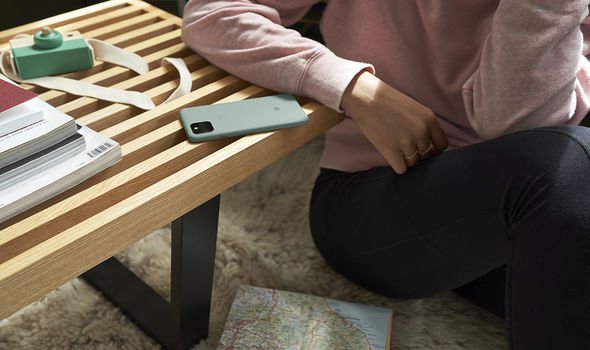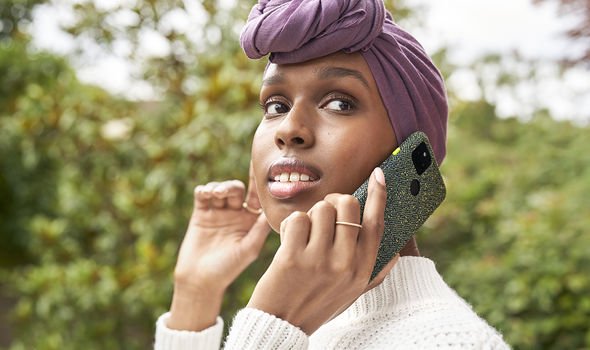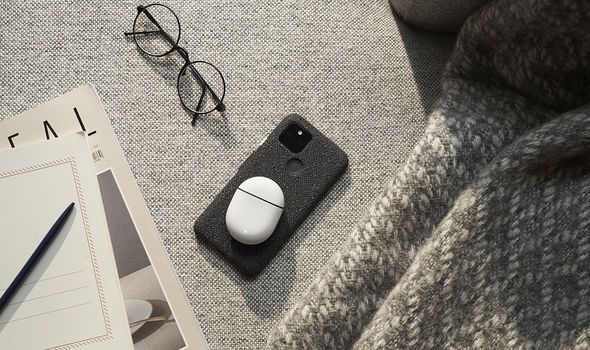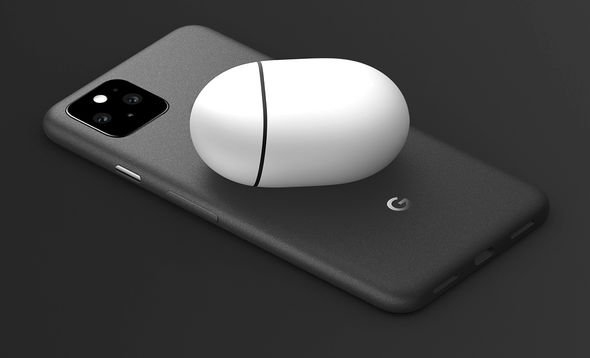Google Pixel 5 looks closer to the Pixel 4a than the flagship Pixel 4 launched last year (Image: GOOGLE • GETTY)
With Pixel 5, Google is trying something different. Last year, Pixel 4 became the first Android handset to match the Face ID facial recognition system found on the iPhone – allowing users to authenticate payments and log in to banking apps with a glance. Not only that, but it added a second telephoto camera for improved zoom and a radar to detect hand gestures above the screen. So, how does Google follow that?
Well, Google has taken the unconventional approach of ditching it all. Gone is the facial recognition system. Gone is the telephoto camera. Gone is the radar to detect hand waving.
Pixel 5 has more in common with the affordable Pixel 4a announced earlier this summer than the flagship Pixel 4 that preceded it. Given how much we adored the Pixel 4a when we reviewed it a few months ago, that’s no bad thing. Express.co.uk has been using the Pixel 5, here are our in-depth impressions of the device.
Google Pixel 5 review: Release date, Price
Pixel 5 launched on October 15 in the UK. Ahead of its release Google had already sold-out of all storage variants, which suggest that it’s either the most popular Pixel launch in years, or Google – like almost every other manufacturer – is struggling to produce enough smartphones during the public health crisis. With any luck, PIxel 5 will become less scarce in the coming weeks and months, but for the time being, it’s worth signing up for a stock alert.
Pixel 5 only ships in a single configuration – with 8GB of RAM and 128GB of non-expandable storage. This costs £599 SIM-free. It’s available in Sorta Sage and Just Black.
Google Pixel 5 review: Design
From the outside, Pixel 5 looks almost identical to Pixel 4a. It has the same square camera bump on the back and small cut-out in the top left-hand corner of the display to house the selfie camera. Unlike the £349 Pixel 4a, the Pixel 5 is constructed from aluminium.
However, don’t expect to feel the chill of metal when you pick-up the phone. Instead, Google has covered the back of the Pixel 5 in a tactile plastic coating that feels a little like cardboard. It’s not unpleasant, but it doesn’t feel anything like as premium as similarly priced smartphones, such as iPhone 11, Samsung Galaxy S20, and OnePlus 8T. The switch to an aluminium case means Google has had to ditch the squeezeable sides to trigger the Google Assistant. That’s a real shame. Squeezing the phone in your hand to launch the chatty AI assistant was really handy and gave the Pixel series some much-needed personality.
Of course, you can still summon Google Assistant by saying “Hey Google” or “OK, Google,” as well as swiping up from the bottom corners of the display. These work well enough, but we’re keeping our fingers crossed that the squeezy sides make a comeback in future Pixels.
Google has dropped the separate “XL” version of the Pixel this time around, so you’ll only find a single choice of screen size in the entire range. Fortunately, Google has picked a pretty perfect size for its new one-size-fits-all approach.

Pixel 5 is only available in two colourways, Just Black and Sorta Sage (Image: GOOGLE)

Night Sight now works with Portrait Mode, so you’ll always be able to get a gorgeous DSLR-like shot (Image: GOOGLE)
Thanks to the almost border-less edge-to-edge design, Pixel 5 feels pretty compact despite its six-inch screen. In fact, Pixel 5 is 2.4mm shorter than the Pixel 4, which only had a 5.7-inch display. In comparison to the vast majority of Android rivals in this price range, Pixel 5 is one of the most compact smartphones around. It’s easily manageable with one-hand, so you won’t need to invest in a Pop Socket to reach the top of the touchscreen.
The OLED panel is bright, vibrant and impressively sharp 432 pixels-per-inch. It’s also a high refresh-rate display, clocking in at 90Hz. That’s not as smooth as the panels you’ll find on the top-end gadgets from Samsung and OnePlus, but it’s still noticeably better than the 60Hz refresh-rate you’ll find on every iPhone.
Pixel 5 automatically adjusts between refresh rates in order to preserve battery life. So, if you’re watching a Hollywood blockbuster, which is shot at 24 frames-per-second, there’s no need for the display to be refreshing 90 times every second. However, when you’re playing fast-paced games or scrolling through lists – Google will make full use of its 90Hz display.
Google is using a rear-mounted fingerprint scanner to unlock the handset and authenticate contacless payments. It’s fast and works well, but for our money, we prefer a fingerprint sensor or facial recognition on the front of the device – as it means you can check text messages, emails and notifications when using a charging stand, like the awesome Pixel Stand launched by Google last year, or have the handset lying on a desk without having to constantly pick it up. It’s a small thing, but given Google’s Digital Wellbeing tells us that we pick up our smartphone dozens of times a day… it’s one that crops up a lot.
There’s nothing particularly flashy about the Pixel 5. It’s very functional, but it’s not going to be troubling the judging panel at any design award shows this year.
Some interesting new colours might’ve helped, but the Sorta Sage and Just Black options are as understated as the rest of the design. Considering the team behind the Pixel includes some of the brightest minds from HTC, which once gave Apple a run for its money with their premium Android handsets, it all feels a little underwhelming. At £599, that’s not too much of an issue, but it would’ve been nice for the design to make a splash this year.

Despite the sizeable 6-inch screen, Google has done a solid job keeping the handset nice and compact (Image: GOOGLE)
Google Pixel 5 review: Camera
There’s no denying that the camera has always been the jewel in the Google Pixel’s crown. For years, Google set the agenda when it comes to computational photography – forcing Apple, Samsung and OnePlus to play catch-up with features like Night Sight. Unfortunately for Google, most of these rival firms have managed to catch-up in the years since the ground-breaking Pixel 2 and iterative Pixel 3 …and, like everything else about the Pixel 5, the changes are pretty understated this time around.
With Pixel 5, Google is still relying on the same 12-megapixel sensor as the Pixel 2. According to the Mountain View-based company, this consistency has enabled its ever-improving software and Artificial Intelligence (AI) to eke the most out of the hardware. And it’s true that photographs from the Pixel 5 look as good as they’ve ever looked from these sensational smartphones… but that’s about it. Pixel 5 doesn’t really move things on.
And when compared with images from the 48-megapixel camera on the similarly-priced OnePlus 8 Pro, the lack of detail when cropped-in really starts to show. If you’re planning to print your next holiday photos on canvas, you might want the extra few megapixels.
Images from the Pixel 5 still have that trademark “Pixel look”. That means details are incredibly crisp without looking oversharpened and colours are vibrant without looking oversaturated. While previous Pixel smartphones have tended to produce cooler images, Pixel 5 images are much warmer. Your mileage may vary, but we’re a big fan of the change.
The second camera in the dual set-up on the Pixel 5 is an ultra-wide. This is incredibly good fun – from squeezing in a big group of (socially distant) friends, capturing a skyscraper, or simply trying to create a bit of an arty shot on your next trip away, ultra-wide cameras are great. It’s a shame that Google hasn’t added an ultra-wide selfie camera on the front of the handset – one of the headline features of the Pixel 3 – but we’ll take what we’ve got.
One of the biggest new additions is Portrait Light. Using its immensely clever AI, Google creates a depth map of the contours of your face and body. Using the Google Photos app, you can drop an artificial lightbulb onto the image and illuminate different parts of the subject at different strengths. So, if you’re looking for a moody shot with harsh light from one side, or want to brighten all of your features… Portrait Light works incredibly well. And since it’s not reliant on a fancy new depth-sensor or anything like that, Portrait Mode images shot with previous Pixel phones in your library can be edited using Portrait Light on the new handset.
Elsewhere, Google has enabled its clever Night Sight mode with Portrait images, so you’ll be able to get that gorgeous bokeh-style blur without blinding friends with the LED flash. This works like a dream – and will leave social media followers convinced that you’ve been carrying a hefty DSLR camera with you on all of your nights out. Like previous Pixels, Google lets you adjust the amount of background blur after the fact.
Google is still ahead of the competition when it comes to Portrait Mode images. The supremely clever software can pick out individual hairs while blurring the background, so you won’t get the incredibly soft edges around your subject that sometimes occur with the iPhone, or OnePlus equivalent modes. However, because of the sharp contrast between the subject in focus and the background, whenever Google’s AI gets a little confused – and it still does on occasion – the results look much worse than its rivals. We’ve seen random portions of text on signs over our subject’s shoulder pop into focus when everything else is blurred, or jacket sleeves smoosh into the background below the elbow.
Compared with the crisp shots from the rear-facing camera, photos from the 8-megapixel selfie camera look a little soft. Google has included some optional skin-softening options, which don’t help things either. However, Night Sight means you’ll be able to get some great selfies even in dimly lit restaurants and bars. If you’re a keen selfie shooter, you’ll want to swerve the Pixel 5 – Apple and Samsung handsets at this price offer more detailed images.
Google Pixel 5 review: Performance
For the first time, the top-tier Google Pixel isn’t powered by the latest and greatest from Qualcomm.
Forgoing the Snapdragon 855 Plus, it packs a Snapdragon 765G under the bonnet instead. In most instances, you won’t miss the extra oomph of the Snapdragon 855 Plus, however, when processing some of the most complicated images (Night Sight, Portrait Images, Photo Spheres, and more) it can take a little while. Immediately opening Google Photos after snapping an image, you’ll see the progress bar slowly chugging away – so you might have to wait before you can inspect your handiwork.
Thankfully, Google has removed the burst mode from its default camera, as we’re not convinced the Snapdragon 765G could handle it.

Gone is the immensely clever facial recognition system, replaced with a rear-mounted fingerprint scanner (Image: GOOGLE)
We haven’t had the Pixel 5 in our pocket long enough to make a definitive ruling on battery life. But what we’ve seen so far is very, very promising. Especially given how disastrous the battery life was on the Pixel 4 – barely lasting a morning with the 90Hz display switched on, let alone an entire day! Google is confident enough in the longeivity of the 4,080mAh cell inside the Pixel 5 that it allows users to put friends’ smartphones or wireless earbuds, like the Pixel Buds, on the rear case to charge them from the Pixel. It’s a really nifty feature that could get you out of a bind if you haven’t packed enough charging cables for all of your gadgets on a trip away – or running low on battery.
One of the biggest selling points with the Pixel line-up has always been the speed that you’ll get the latest updates from Google. That’s still true – Pixel 5 ships with Android 11 pre-installed – but it’s not as much of a big deal as it has been in previous years. After all, OnePlus launched a smartphone with Android 11 preinstalled in the same week as pre-orders for the Pixel 5 went live. Not only that, but Samsung and OnePlus have both matched Google’s promise to keep their devices updated with new features and security patches for three years. Buying a Pixel is still a great way to ensure that you get the latest features …but it’s not the only way, like it was three years ago.

Google has improved battery life … so much so that you can charge other devices from Pixel 5 (Image: GOOGLE)
Google Pixel 5 review: Final Verdict
- Pros: That Trademark Pixel Camera, Night Sight Works With Portrait Mode, Great Size For One-Handed Use, Android 11
- Cons: Processing Some Images Can Take A Little While, Rear-Mounted Fingerprint Isn’t As Useful As Facial Recognition
There’s something incredibly charming about Pixel 5. Sure, it has a pretty drab design and the cardboard-like texture of the case won’t appeal to everyone, but the clean Android operating system and great camera make this an easy recommendation. It’s not the flashiest flagship, but this is a very dependable handset with solid battery life and performance.
The addition of 5G, while far from a must-have feature right now, means you’ll be futureproofed when coverage becomes more widespread across the UK. If you’re planning to hold onto your next smartphone for three or four years, that’s important.
Easy to use one-handed and fit into your jeans or handbag, the Pixel 5 is a refreshing change of pace in a sea of palm-straining Android flagships. The six-inch OLED display is bright and colourful, while the high refresh-rate makes everything feel responsive. Selfies are a little lacking, but Night Sight and Portrait Mode on the rear-camera still ensure the Pixel 5 remains competitive… although for the first time since the launch of the Pixel 2 in October 2017, it’s starting to feel as if Google could fall behind its rivals in the next year or so.
Pixel 5 feels more like an upgraded Pixel 4a, rather than a successor the Pixel 4. Given how much we liked the Pixel 4a, that’s not a problem. But we’re not convinced Google has done enough to justify the £250 price hike between the Pixel 4a and Pixel 5 for most people.
Only you’ll be able to decide whether a high-refresh rate display, 5G support, ultra-wide camera and reverse-wireless charging to top-up your earbuds from the back of the phone is worth £250 extra. But whichever you pick, you’ll have some stunning photos to show for it.



